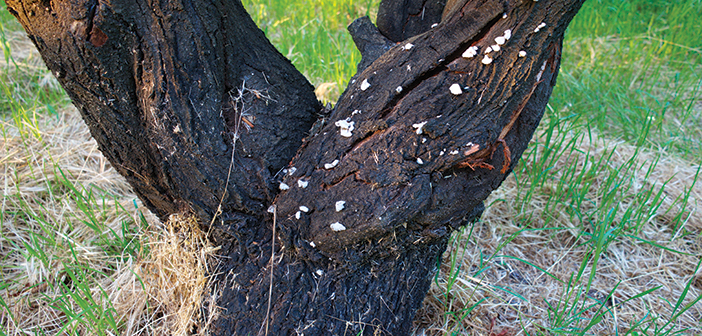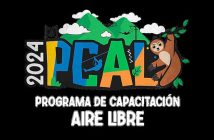If you have trees on your course, you’ve probably experienced the challenge of articulating your tree observations to an arborist. Your explanation likely elicited follow-up questions. “Was the mushroom growing on the tree, or next to it?” “Did you see actual evidence of insects?” That’s because the answers to these questions provide clues to the reasons why trees are declining or reacting in certain ways.

Insect frass and pitch tubes are signs of insect infestation. Trees expel sap to push out insects, which forms thick pitch tubes.
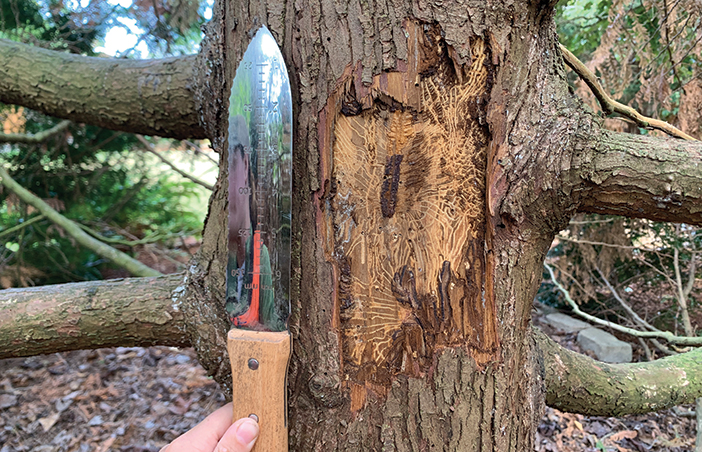
Galleries beneath bark are unique fingerprints to insect species. With knowledge and training, you can positively identify insects from these intricate galleries.

Canopy or branch dieback is a common symptom of abiotic stress. Reasons for this decline may be difficult to diagnose.
Learning how to read trees will help you and your staff make educated decisions on tree and ecosystem management throughout your course. To better diagnose and explain tree issues, you should learn to recognize whether the tree stress you are observing is a result of biotic or abiotic factors, and understand the differences between signs and symptoms.
BIOTIC VS. ABIOTIC FACTORS
Biotic issues are caused by the living organisms of the ecosystem, such as insects, fungi, bacteria, plants, and animals. Abiotic disorders are caused by nonliving physical and chemical factors that derive from the earth and its surrounding atmospheric layers. Abiotic factors that impact trees can include drought, sunscald, freeze, nutrient deficiencies, and improper pesticide applications.

One easy way to think of it is that biotic, which is Latin for “pertaining to life,” represents all living or formerly living components. Abiotic, which is Latin for “not living,” encompasses environmental factors, such as temperature, that can have long-term impacts on the survival of living organisms.
SIGNS VS. SYMPTOMS
These biotic and abiotic stressors generate signs and symptoms that we can then observe and identify. Both signs and symptoms can indicate a potential issue. It can take a well-trained eye to distinguish these abnormalities. Some are obvious, like a mushroom growing on a tree trunk. Others can be more subtle, such as a slight discoloration of foliage.
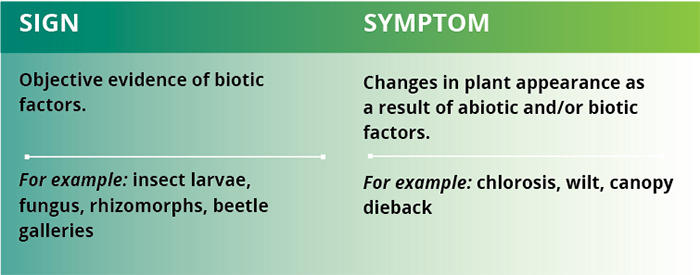
It is important to distinguish between signs and symptoms. A sign is objective evidence, such as “I found a mushroom on a tree trunk,” which can help diagnose a specific tree problem. A sign is an indication of the existence of a pest or disease, and typically points to biotic factors. Examples of insect-related signs include finding physical adult and/or larval insects on or in a tree, insect galleries beneath bark, pitch tubes and frass (excrement), caterpillar webs, and exit/entry holes on the surface of a tree.
A symptom is more subjective, such as “that tree looks pale,” which could be the result of many different factors—making it difficult to diagnose the specific tree problem. A symptom is evidence of a tree’s response to stress when under attack from either biotic or abiotic (environmental) factors. Examples include off-color needles or leaves, wilting leaves, canopy dieback or decline, heavy cone production, and the formation of new sprouts along branches or trunks.

Correlation is not causation. It is important to note that correlation doesn’t always equal causation. Finding signs of biotic stressors may not be conclusive evidence that the observed pest is the agent killing the tree. A root cause, like drought, flooding, or even another pest, can weaken a tree, making it more vulnerable to subsequent attacks by a variety of things.
Tree issues are often multi-faceted, caused by both biotic and abiotic factors and evidenced by both signs and symptoms. A good arborist will diagnose the problem and provide recommendations, but operators can be proactive and spot the issues before they become major problems.
KNOW YOUR SPECIES
When it comes to reading biotic signs, it helps to know your species. For example, most fungi are beneficial to trees, and only decompose already dead organisms. These fungi are referred to as saprophytes. However, there are some decay-causing fungal diseases; these are called parasites. Parasites, if severe enough, can lead to tree decline. But parasitic fungi have a role to play in ecosystems and often can live in trees for decades without causing trees to die or fail, so their presence should not automatically condemn a tree.
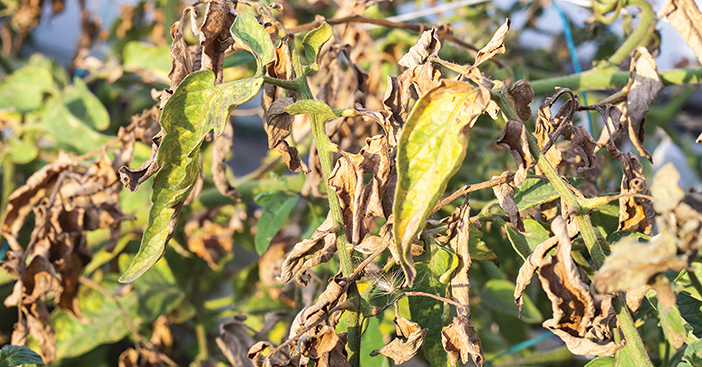
Wilt or discoloration in the veins of leaves is a symptom that can be related to nutrient deficiencies, drought stress, insect damage, and more.

Advanced sonic tomography performed due to presence of Ganoderma applanatum conk. The presence of a fungal conk does not always mean a tree should be condemned. Consult with an ISA certified arborist and Qualified Tree Risk Assessor to gain more information and make educated decisions.
Make sure you are familiar with the parasitic fungi in your area (there are likely only a handful of them) and know how to identify them. Fungal fruiting bodies come in all shapes and sizes, and are often specific to tree species.
Understanding the health, growth rate, and age of a tree are important when it comes to determining how a particular fungi might impact the tree in the long term. For example, artist’s conk (Ganoderma spp.) fruiting bodies are extremely common on older maple trees. The presence of one small conk on the trunk likely has minimal impact on the tree’s ability to thrive. If the tree is inundated with fast-growing and expanding conks, and other visual indicators of decay and growth deficits are present, the structure of the tree may be in question and should be assessed more closely.
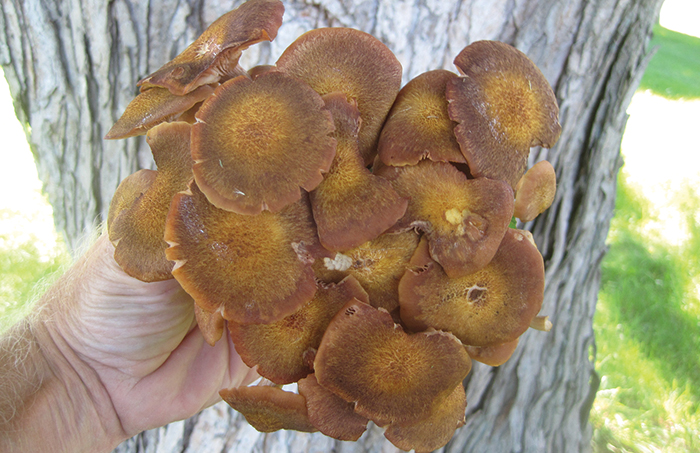
Fruiting body of honey fungus (Armillaria spp.)
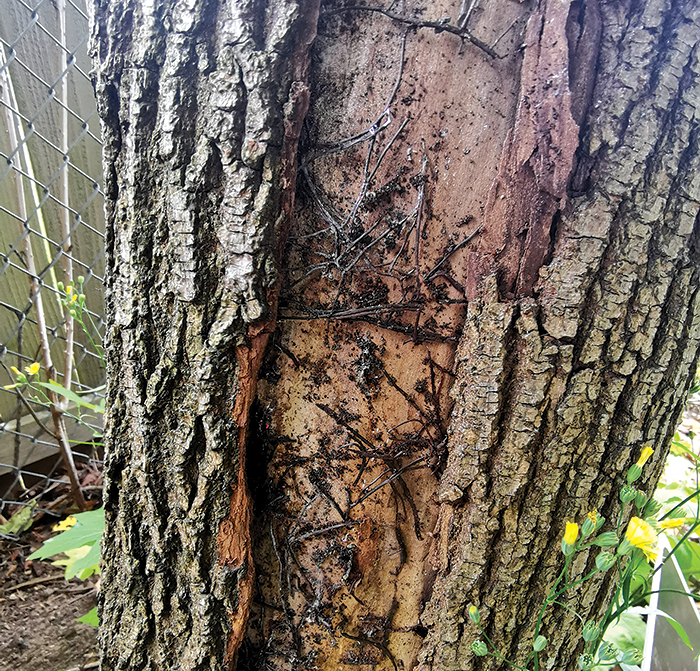
Rhizomorphs from honey fungus.
IN REVIEW
Understanding abiotic and biotic factors and the difference between signs and symptoms will help you to identify the potential stress indicators you see in the trees throughout your course and make informed decisions about tree and ecosystem management. While consulting a qualified arborist is the most effective way to ensure you are correctly diagnosing tree issues, you can maintain the ecosystem value of your property by staying on top of tree health. Regular observations aimed at recognizing tree-related issues will help protect your ecosystem and can alert you to burgeoning problems in time to prevent long-term or major damages.
So read, and re-read, your trees. They tell an ever-changing and valuable story.


